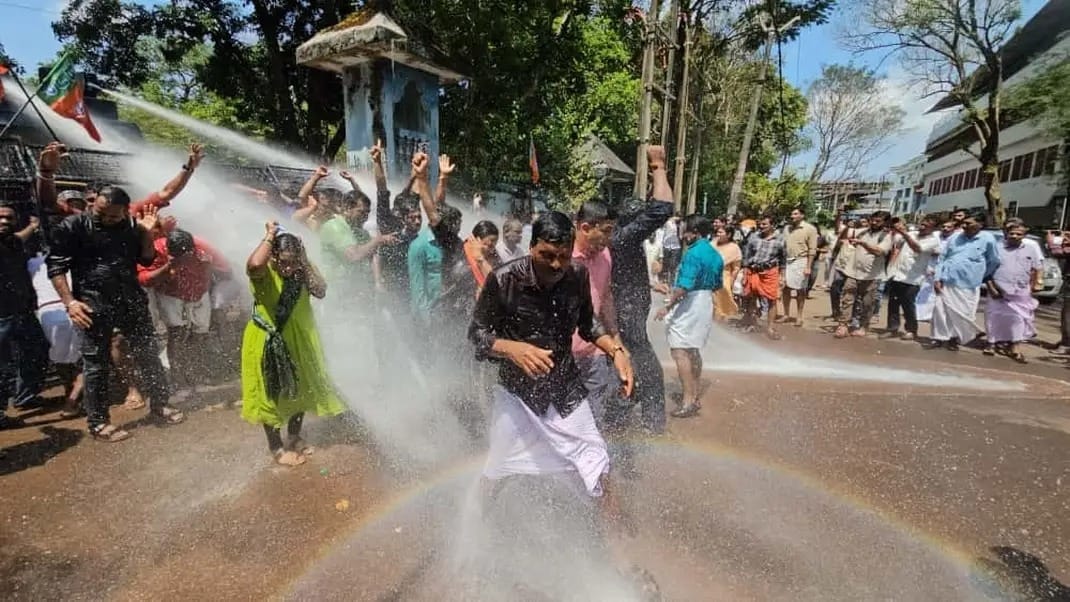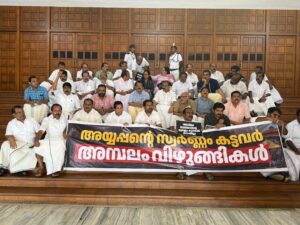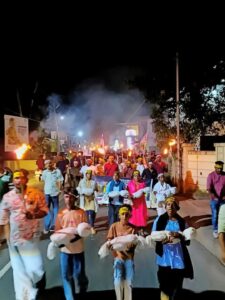Kerala’s simmering streets signal that 2026 Assembly polls won’t just be fought in TV studios or party offices — it will be fought on ground.
Published Oct 12, 2025 | 12:00 PM ⚊ Updated Oct 12, 2025 | 12:00 PM

Scenes from a BJP protest on Sabarimala issue that turned violent.
Synopsis: In 2025, Kerala’s political landscape sees intense street protests. While CPI(M)-led LDF opts for digital rebuttals over mass mobilisation, BJP targets Hindu temple issues, and Congress leverages democratic and local grievances. Religious polarisation, social media amplification, and emerging coalitions shape the high-stakes contest ahead of local and 2026 Assembly polls, with Sabarimala season poised to escalate tensions.
The calm on Kerala’s streets has given way to a charged, combustible energy. What was once a lull has now turned into a season of confrontations — slogans, barricades, lathicharges, and rising political heat.
As local body elections loom and Assembly polls draw closer, parties have shifted gears from slumber to full-throttle street politics – the protests are fiercer, the police action swifter, and the political messaging sharper.
Protests over the alleged gold loss at Sabarimala and against the police action against Congress MP Shafi Parambil are just the latest flashpoints in what is fast becoming a familiar pre-election pattern: escalating agitations, sharpening rivalries, and the battle for public sentiment playing out on the streets.
The state is now stepping into a volatile, action-packed countdown to the polls.
The opposition Congress-led United Democratic Front (UDF) and the Bharatiya Janata Party (BJP), in the last five months, has intensified their street campaigns with renewed energy, challenging the ruling CPI(M)-led Left Democratic Front (LDF) on governance, corruption, and communal issues.
While Congress framed its mobilisations around democratic values and police excesses, the BJP amplified temple controversies and communal flashpoints, aiming to consolidate its emerging vote base.
The LDF, in power since 2016, largely kept off the streets, choosing instead to defend its governance record through institutional and digital channels.
Observers say the escalations reflect an Opposition determined to capture the anti-incumbency sentiment well before the 2025 local body and 2026 Assembly elections.
The BJP, buoyed by its improved showing in the 2024 Lok Sabha polls, rolled out one of its most assertive statewide agitation calendars in recent years.
It began with counter-protests during the Waqf Amendment Bill controversy in June–July, using local flashpoints like Cherai–Munambam land disputes to attack both the LDF and UDF as “pseudo-secular” forces shielding extremists.
Catholic groups lent tacit support, adding weight to the protests that peaked on July 12 after a fiery rally by Union Home Minister Amit Shah.
From July onwards, the BJP held what it called “change rallies” across 21 districts, drawing an estimated one lakh participants. The message was clear: paint the LDF as corrupt and the UDF as complicit.
In August, following the vandalism of Union Minister Suresh Gopi’s Thrissur office on 12 August, BJP’s Yuva Morcha launched a series of dharnas across Thrissur, Kannur, and Palakkad.
These clashes with police helped the party project itself as an embattled but rising challenger. The party also launched heavy protests in Palakkad after sexual allegations came up against Palakkad MLA Rahul Mamkootathil.
The party’s most potent flashpoint came in October with the Sabarimala gold-plating scandal, where missing artifacts from the Ayyappa shrine triggered outrage.
On 8 and 9 October, saffron-clad protesters led by Rajeev Chandrasekhar staged dharnas outside the CM’s residence and Travancore Devaswom Board offices, accusing the government of “temple looting.”
BJP’s social media campaign branded it “temple chori,” syncing seamlessly with its Hindutva narrative.
This temple-focused agitation, observers note, is a calculated move to consolidate the party’s 12–15 percent vote share in Hindu-majority central Kerala while creating pressure points in constituencies traditionally controlled by the Left.

UDF MLAs staging a sit-in protest at the Legislative Assembly on Sabarimala issue
If the BJP mobilised around temple issues, the Congress and its UDF allies framed their protests around democracy, governance failures, and police brutality.
The #VoteChori campaign, launched under Rahul Gandhi’s leadership, became the centerpiece of its agitation.
From July to September, Congress organised over 280 block-level protests across the state, including night marches, signature drives, and rallies.
The campaign accused the Election Commission and BJP of manipulating voter lists, while simultaneously attacking the LDF for “complicity” in undermining democratic processes.
On 29 September, 282 block committees marched from Martyrs’ Square to Raj Bhavan in Thiruvananthapuram, responding to death threats against Rahul Gandhi and custodial torture allegations in Kunnamkulam.
UDF MLAs AKM Ashraf and Saneeshkumar Joseph later launched a hunger strike in the Assembly, intensifying pressure on the government.
UDF also leveraged religious flashpoints strategically. During the Waqf Bill row, IUML rallies in Malappuram and Kozhikode brought thousands to the streets, giving the Congress-led front a robust Muslim mobilisation platform against both BJP and LDF.
The Congress led UDF also took up the Sabarimala gold missing scandal to corner the Left government as it stalled Assembly proceedings for four straight days and has hit the streets demanding Devaswom Minister’s resignation.
The protests reached a crescendo in October after visuals of police action against MP Shafi Parambil in Perambra went viral, sparking statewide solidarity marches.

CPI(M)’s Palestine solidarity march
In sharp contrast to the frenetic opposition activity, CPI(M)-led LDF preferred a muted street presence.
While the party did stage large marches in June–July against the Waqf Amendment Bill—mobilising over 50,000 in Malappuram, Kozhikode, and Kannur—it gradually retreated from major street agitations after August.
The August vote-fraud row, which saw clashes and contempt cases, marked the last major CPI(M)-led street action. During September and October, as controversies piled up—from Rahul Gandhi threats to the Sabarimala gold scandal—the ruling front chose digital rebuttals and legislative defenses instead of mass mobilisation.
CPI(M)’s official handles posted tributes, policy highlights, and accusations of “central discrimination” in disaster aid—but avoided direct confrontation on the streets, a strategy political analysts say reflects its confidence in organisational strength but also its caution in the face of growing unrest.
However, the party especially its youth outfits launched protests which often turned violent in the Rahul Mamkootathil issue.
Kerala’s political protests in 2025 reveal a recalibration of street politics. BJP is sharpening its focus on Hindu temple issues and local land disputes to eat into the LDF’s Hindu base.
Congress, meanwhile, is tapping national democratic narratives and local law-and-order grievances to reassert its relevance as the principal opposition.
Meanwhile, LDF is banking on administrative legitimacy rather than street muscle, though this approach carries risks if anti-incumbency gains momentum.
It seems three major trends driving this churn:
Religious polarisation is becoming a sharper campaign tool, with temple issues like Sabarimala returning to the forefront.
Social media amplification—especially through hashtags like #VoteChori and BJP’s “Temple Chori” narrative—has blurred the lines between street and digital mobilisation.
Coalitional possibilities—while not yet formal, are emerging in issue-based alignments on Hindu rights and governance questions.
With local body elections due in 2025 and the Assembly polls just months later, Kerala’s political contest is spilling onto the streets earlier than usual.
For the BJP, it’s about expanding beyond its saffron islands.
For Congress, it’s a bid to reclaim lost ground.
For the LDF, it’s a tightrope walk between projecting stability and countering growing unrest.
As the Sabarimala season approaches, all eyes will be on whether these fragmented protests coalesce into larger anti-incumbency coalitions or remain parallel tracks in a crowded political field.
Either way, Kerala’s simmering streets signal that 2026 Assembly polls won’t just be fought in television studios or party offices — it will be fought on the ground.
(Edited by Amit Vasudev)
